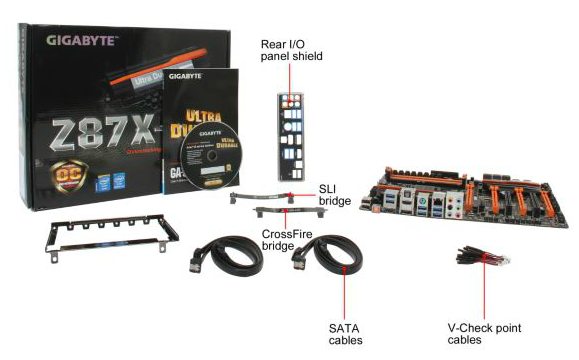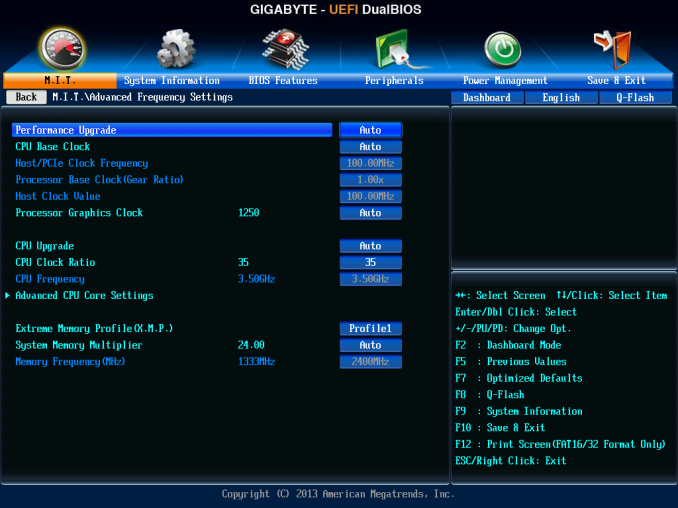GIGABYTE Z87X-OC Review: Overclocking Oriented Orange at $200
by Ian Cutress on October 11, 2013 10:00 AM EST- Posted in
- Motherboards
- Intel
- Gigabyte
- Z87
GIGABYTE Z87X-OC In The Box
Over the ~3 years I have been reviewing motherboards at AnandTech, I very rarely come across a motherboard package (on the Intel side) under $250 that has not made a compromise or two in the box package. Sometimes there is a USB 3.0 bracket at this price range, but as this is an OC board so there should be some OC related paraphernalia.
In the box we get:
OC Brace (with screws)
Rear IO Shield
Manual
Driver CD
SLI Bridge
Crossfire Bridge
Four SATA Cables
V-Check Point Cables

It is still nice to see a Crossfire bridge inside a motherboard box! Typically SLI is all we get, due to the different bundling policies of AMD/NVIDIA. On the OC side we see the Brace and voltage check point cables to bolster the offering, and finally a set of SATA cables.
GIGABYTE Z87X-OC Overclocking
Experience with GIGABYTE Z87X-OC
GIGABYTE overclocking is always a little odd for some reason. Despite the new graphical BIOS design, my brain prefers to go back and use the ‘classic’ mode for adjusting settings, just because of the deeper color contrast.
In terms of 24/7 stable overclocking, the OC specific additions to the Z87X-OC are more left in the BIOS and software rather than the OC Touch buttons – the point of a stable system is not one you boot into then manually adjust the frequencies. Through EasyTune, three OC modes are offered, most of which worked on our sample.
For manual overclocking, our CPU is more often the bottleneck as with other Z87 reviews – 4.6 GHz is easily achieved but too much voltage is needed to push it beyond this. At 1.4 volts the system gets too warm under our stress tests to warrant further stability testing. Nonetheless, we were able to boot at 5.1 GHz, albeit unstable, suggesting that with more voltage and the right cooling that this is possible.
Methodology:
Our standard overclocking methodology is as follows. We select the automatic overclock options and test for stability with PovRay and OCCT to simulate high-end workloads. These stability tests aim to catch any immediate causes for memory or CPU errors.
For manual overclocks, based on the information gathered from previous testing, starts off at a nominal voltage and CPU multiplier, and the multiplier is increased until the stability tests are failed. The CPU voltage is increased gradually until the stability tests are passed, and the process repeated until the motherboard reduces the multiplier automatically (due to safety protocol) or the CPU temperature reaches a stupidly high level (100ºC+). Our test bed is not in a case, which should push overclocks higher with fresher (cooler) air.
Automatic Overclock:
For our automatic overclocks, we skipped straight into the EasyTune software, under the Smart Quick Boost Tab:
We get five main overclock options which gave the following results:
The ‘Light’ setting rebooted the system to 4.1 GHz (41x100), which under load gave 1.064 volts on the CPU and a PovRay score of 1706. Unfortunately this was not enough voltage for our sample to sustain a 5 minute OCCT stress test.
The ‘Medium’ setting rebooted the system to 4.3 GHz (43x100), which under load gave 1.264 volts on the CPU and a PovRay score of 1785.38. The peak temperature reported in our OCCT stress test was 77ºC.
The ‘Extreme’ setting gave 4.5 GHz (45x100) at the same load voltage as Medium, 1.264 volts. This resulted in a PovRay score of 1867.32 and an OCCT peak temperature of 78ºC.
The ‘Energy Saving’ mode causes the CPU to idle speeds at any loading, meaning 800 MHz (8x200. This gave a peak voltage of 0.883 volts on the CPU and a PovRay score of 317.30. The OCCT stress test gave a peak temperature of 38ºC.
The final setting, ‘Auto Tuning’, requires flash to be installed. When it gets going, the program stress tests the system for stability, raising the multiplier. When the system had finished, we had a graduated turbo result, giving 5.0 GHz in single core mode and 4.8 GHz in multithreaded mode, with the BIOS set to 1.545 volts. This is quite an alarming voltage for an i7-4770K, as shown in our stress tests where the CPU would rise above 91ºC and the system would reduce the clock speed to compensate. We got a PovRay score of 1779.53 (~4.35 GHz average) and the OCCT stress test failed with a BSOD.
Manual Overclock:
For our manual overclocking, while the OC Touch buttons are available, in order to get a rock stable 24/7 overclock we headed to the BIOS. Due to my eyesight not enjoying the variable contrast of HD mode, I usually skip into the classic mode for the overclocks:
As with other Z87 overclock testing, we start with 40x100 on the CPU at 1.000 volts. If this is unstable (PovRay + 5 min OCCT), the voltage is raised by +0.025. If it is stable, we make a note of the voltage/multiplier combination and raise the multiplier by one. Ultimately the limit is how comfortable the temperatures are. Here are the results:
Ultimately our main limitation is with our CPU sample. The *good* i7-4770K CPUs that end up in highly overclocked prebuilt systems can pass 3DMark Vantage at 4.8 GHz with 1.25 volts, which apparently indicates a 1 in 25 CPU. Our CPU seems to top out at 4.6 GHz, with anything higher than that needing an insane voltage to keep stable. We were able to boot into Windows at 5.0 GHz, although this was not stable under load.













23 Comments
View All Comments
IanCutress - Friday, October 11, 2013 - link
With the last few generations, it's always been about 'have you got a good chip?'. A good OC chip of Ivy (or Sandy) has always been better than a bad chip this gen, and sometimes there isn't the certainty of getting a good chip this time around. That means the only jumps where it makes sense is when a bad chip in the newest gen beats your good chip. Each gen seems to give a 200-500 MHz IPC advantage (at 4GHz) depending on the CPU benchmark test (less in gaming), and you need to decide when that jump takes place if you're on the cutting edge of performance.But if you had a bad chip/ran at stock, then perhaps every two generations it makes sense to upgrade due to the IPC benefits. There are some pretty awesome low power chips this generation for example.
iTzSnypah - Friday, October 11, 2013 - link
I guarantee you that setting your Uncore to x34/35 will make the chip require less Vcore to be stable at any frequency.DanNeely - Friday, October 11, 2013 - link
Another use for the on board USB2 ports would be a thumbdrive to store bitlocker full disk encryption keys since the board doesn't appear to include a TPM keystore. Using an external USB port for that strikes me as mildly dangerous since it would be easy for someone to accidentally borrow the drive for something else.Nirvanaosc - Friday, October 11, 2013 - link
Hi everyone,I've read a lot of reviews already and most of the time I feel that the given motherboard is not enough or too much for what I need.
What would be the best for a day-to-day PC with a 4670K OCed and single GPU? This motherboard looks impressive but I think it's overkill for that purpose.
just4U - Monday, October 14, 2013 - link
It's different for everyone.. For me right now it's the G1 Sniper M5. While Anandtech has mentioned it I don't believe they've reviewed one yet.. I like the onboard sound/lan options which are not the generic Realtek stuff and tend to go matx.. but still want a board that's a cut above.. Asus also makes something similar in their Maximus6 Gene.vailr - Friday, October 11, 2013 - link
Did your board include the updated version Intel C2 chipset? And: did Gigabyte change the board version to 1.1, in order to indicate the presence of the updated C2 chipset? The review's photo shows board version 1.0.HardwareDufus - Saturday, October 12, 2013 - link
I really appreciate the inclusión of 2 HDMI ports instead of a DVI. I would love to find a Premium mini-ITX board that offered 2 HDMI ports.samsp99 - Saturday, October 12, 2013 - link
Does the audio codec really make that much of a difference these days? An old receiver for d2a, or a headphone amp like a fiio e10 solve that deficiency pretty well.CatheyBarrett48 - Saturday, October 12, 2013 - link
First time i trusted an online job add and managed to make 90$ in 5 hours... ℰxit35.comgenzai - Saturday, October 12, 2013 - link
I'm not sure what you mean by "for some reason only two of the chipset USB 3.0 ports are used. There are two USB 3.0 hubs for another eight USB 3.0 ports, and it seems..."If they used all 6 PCH SATA ports and put the FlexIO into PCIe, then they have 4 USB 3.0 ports to work with. 2 of those are routed directly to a FP header and then the other 2 each go to 4 port hubs to give another FP header and 6 rear ports. Seems perfectly logical and maximizes the available configuration.
g\